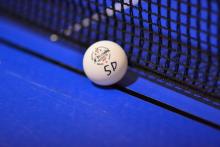Match Analysis
By Samson Dubina
Many players say that they are planning to do some video analysis during this time of isolation. That’s great! But what are you looking at? There are two general categories (Technique and Tactics) and some subtle smaller categories. Let’s take a look at five elements of the technique and give elements of their tactics.
This outline below can be used to study any player. But for an illustration, we are going to use the 2019 China Open Final between Ma Long and Tomokazu Harimoto game two.
It is difficult to study both at one time, so we are going to study only Ma Long today and just going to take a look at game two. Because we are only studying one game, it is impossible to see and understand everything about his technique and tactics. It is best to study at least 10-15 videos including both training and match videos against different opponents.
Today, I’m not trying to say I’m an expert on Ma Long. Today, I am trying to say that you should follow a structure when watching videos. From each of the points that I have listed below, you should be able to write 1-4 sentences. If you can do this, then you have a five page research paper on one game of one match. This is great! Long term, I hope that when you watch TT videos, you can have a better and better understanding of what to look for!
Look at His Technique
Serving
1. From where to where
2. Toss
3. Backswing
4. Contact point on racket
5. 1st bounce
6. Height over the net
7. 2nd bounce
8. Response after serving
Receiving
1. Ready position
a. Distance
b. Racket positon
c. Knees
d. Toes
2. Approach with body and racket
3. Decision making
4. Backswing
5. Contact
6. Follow through
7. Return
Backhand and Forehand Loop and Counterloop
1. Approach
2. Timing
3. Backswing
4. Contact
5. Follow through
6. Placement
7. How it links with the previous ball and next ball
8. Return
Short Game – flip, push short, push long
1. Decision making
2. Approach
3. Timing
4. Ball quality
5. Placement
6. Linking
Footwork
1. General balance
2. General positioning
3. General timing
4. For which shots
5. One or both feet
6. Shuffle
7. 1-step
8. Large in-and-out – 2 step
9. Small in-and-out – 1 step
10. Short game footwork
11. Cross-over footwork for fh
12. Cross-over footwork for bh
Look At His Tactics
Serve and 3rd Ball
1. Which serves were preferred?
2. Which serves worked for direct winners?
3. Which serves worked to setup the point in his advantage?
4. How many variations of his main serve did he have including…
A. Spin variation in type and degree
B. Depth variation
C. Speed variation
D. Toss variation
5. What was his preferred way to safely make the 3rd ball attack?
6. What was his preferred way to finish the point with 3rd ball attack?
Closed game tactics
1. Against short serve and short returns, what did he commonly play?
2. How was he winning the short game?
3. How was he losing the short game?
4. Where was his bh and fh transition balls on short push, long push, and flip?
Open game tactics
1. How did he open into the long game?
A. Long serve
B. Long push
C. Loop against half long
D. Flip
2. Was he playing close, medium, or far in the open game?
3. Did he have any common patterns in the open game that won him points?
4. Did he have any common patterns in the open game that won him points?
Plan A
1. What was his main game plan to win the majority of his points?
2. How often did he use this plan?
3. What were some ways that his opponent stopped him from using this plan?
Plan B
1. If he was surprised and couldn’t execute the plan, what else did he do to win or survive in the point? …for example, blocking, fishing, etc…
2. How often did he enter plan B zone?
3. What were some additional things that he did when surprised?
Additional Things to Look For…
1. What was the reaction to a point won or lost?
2. What was the pre-point preparation?
3. How did he handle controversy with the umpire or opponent?
4. How did he return net balls?
5. How did he return edge balls?
6. Overall, what additional observations can you make?
7. In what ways can you copy him in your own personal game?
8. In what ways would you NOT want to copy him in your own personal game?




